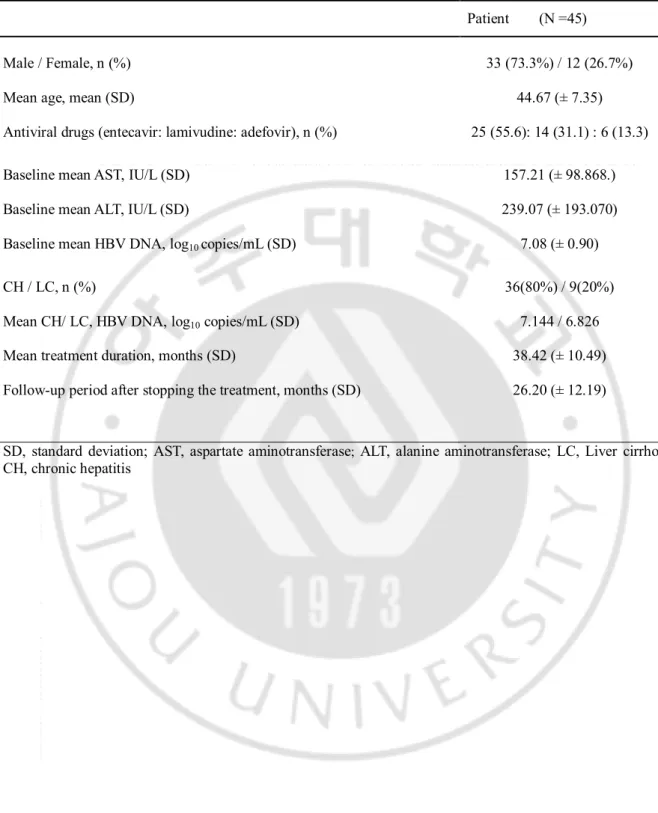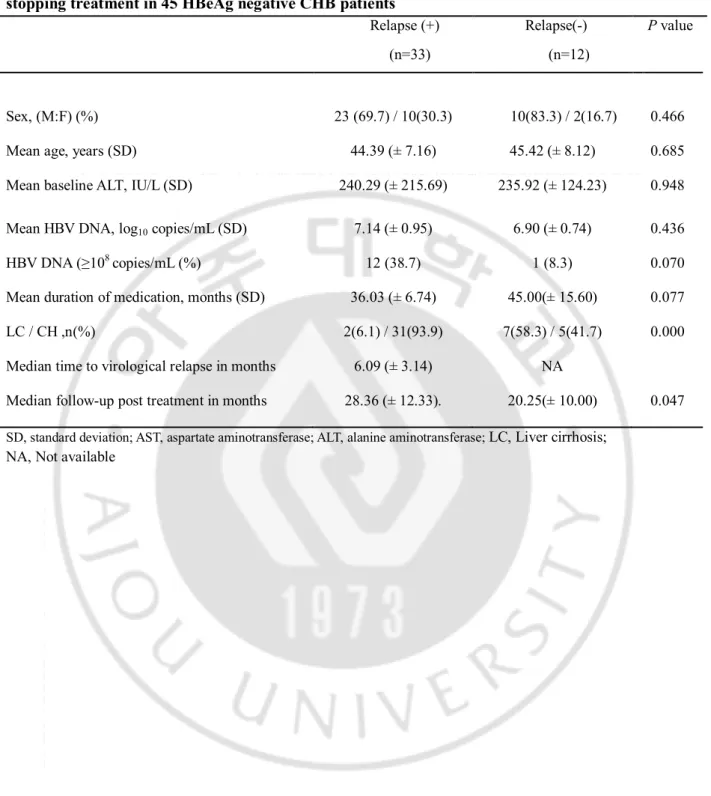저작자표시-비영리-변경금지 2.0 대한민국 이용자는 아래의 조건을 따르는 경우에 한하여 자유롭게 l 이 저작물을 복제, 배포, 전송, 전시, 공연 및 방송할 수 있습니다. 다음과 같은 조건을 따라야 합니다: l 귀하는, 이 저작물의 재이용이나 배포의 경우, 이 저작물에 적용된 이용허락조건 을 명확하게 나타내어야 합니다. l 저작권자로부터 별도의 허가를 받으면 이러한 조건들은 적용되지 않습니다. 저작권법에 따른 이용자의 권리는 위의 내용에 의하여 영향을 받지 않습니다. 이것은 이용허락규약(Legal Code)을 이해하기 쉽게 요약한 것입니다. Disclaimer 저작자표시. 귀하는 원저작자를 표시하여야 합니다. 비영리. 귀하는 이 저작물을 영리 목적으로 이용할 수 없습니다. 변경금지. 귀하는 이 저작물을 개작, 변형 또는 가공할 수 없습니다.
Durability after discontinuation of nucleos(t)ide therapy in
chronic HBeAg negative hepatitis patients
By
Young Jip Kim
Major in Medicine
Department of Medical Sciences
The Graduate School, Ajou University
Durability after discontinuation of nucleos(t)ide therapy in
chronic HBeAg negative hepatitis patients
By
Young Jip Kim
A Dissertation Submitted to The Graduate School of
Ajou University in Partial Fulfillment of the Requirements for the Degree
of Master of Medicine
Supervised by
Sung Won Cho, M.D., Ph.D.
Major in Medicine
Department of Medical Sciences
The Graduate School, Ajou University
This certifies that the dissertation
of Young Jip Kim is approved.
SUPERVISORY COMMITTEE
Sung Won Cho
Jae Youn Cheong
Ki Myung Lee
The Graduate School, Ajou University
May, 5th, 2013
- 1 -
- ABSTRACT –
Durability after discontinuation of nucleos(t)ide therapy in chronic HBeAg
negative hepatitis patients
Background: Relapse has been reported after stopping Nucleos(t)ide (NUC) therapy in the majority
of chronic HBeAg negative hepatitis patients. However, the ideal treatment duration of HBeAg negative chronic hepatitis B (CHB) is not well known. We investigate the frequency of relapse rate in HBeAg negative CHB patients receiving NUC therapy.
Methods: The NUC therapy was discontinued at least three times undetectable level of HBV DNA
leave 6months space in 45 patients. (25 with entecavir, 14 with lamivudine, 6 with adefovir.) All patients had followed up at least 1 year after stopping NUC therapy. Serum ALT, AST and HBV DNA levels were measured every 3 months. Clinical relapse was defined as HBV DNA>2,000 IU and ALT or AST > 2 times of upper limit of normal range. Virological relapse was defined as HBV DNA>2,000 IU
Results: Clinical relapse developed in 16 (35.6%) and 24 (53.3%) patients after stopping therapy at 6
months and 12 months off therapy, respectively. Virological relapse developed 22 (48.9%) and 33 (73.3%) patients at 6 months and 12 months off therapy. The factors such as age, gender, cirrhosis, baseline AST, ALT, HBV DNA levels, treatment duration, and consolidation duration were analyzed to investigate the predictive factors associated with 1 year sustained response. Of these factors, cirrhosis (86.1% in CHB, 22.2% in LC) were significantly associated with 1 year virological relapse. baseline HBV DNA and Total treatment duration tended to be associated with virological relapse.
Conclusions: Virological relapse developed in the majority (73.3%) of HBeAg negative CHB patients
and clinical relapse developed in the half (53.3%) of patients at 1 year off therapy. Cirrhosis was found to be associated with the low rate of virological relapse.
- 2 -
TABLE OF CONTENTS
ABS T R ACT ……… 1 TABLE OF CONTENTS ……… 2 LIST OF FIGURES .……… 3 LIST OF TABLES ………... 4 I. INTRODUCTION ……….. 5II. MATERIALS AND METHODS ………... 6
A. Subjects………..……….. 6 B. Methods………….……….……. 6 C. Statistical analysis ……….……. 6 III. RESULTS ………..…… 7 IV. DISCUSSION ……… 14 V. C O N C L US I O N … … … 1 5 R EF ERENC ES ……… 16 국문요약 ……… 18
- 3 -
Figure 1. Cumulative rates of virological(a) and clinical(b) relapse after NUC withdrawal in 45 HBeAg negative CHB patients …...……… 10 Figure 2. Virological Relapse rates at 12 months after treatment withdrawal according to the kind of
- 4 -
Table 1. Baseline characteristics of patients …….……….. 8 Table 2. Comparison of patients with and without virological relapse within 12 months after stopping
- 5 -
I. INTRODUCTION
About 400 million people worldwide are chronically infected with the hepatitis B virus (HBV).(Lee, 1997; Lai et al., 2003) The prevalence of HBeAg negative chronic hepatitis B (CHB) is increasing in the last 3 decades worldwide. (Hadziyannis and Vassilopoulos, 2001; Papatheodoridis and
Hadziyannis, 2001; Funk et al., 2002; Manesis, 2006) Most HBeAg negative CHB has been shown to be associated with mutations in the precore or core promoter regions of the HBV genome that unable to produce HBeAg. (Hadziyannis and Vassilopoulos, 2001; Papatheodoridis and Hadziyannis, 2001; Manesis, 2006) HBeAg negative CHB patients tend to be more severe and progressive disease pattern with very rare spontaneous remissions, comparison with HBeAg positive CHB.(Hadziyannis and Vassilopoulos, 2001; Papatheodoridis and Hadziyannis, 2004) The HBsAg seroconversion is only achieved in small portion of CHB patients with nucleos(t)ide (NUC) treatments. The clinicians realistic goal is suppression of HBV DNA level, alternatively. (Yuen and Lai, 2011)
It is important to know when the NUC can be stopped safely, because NUC antiviral resistance might be concerned with its duration. (Liaw et al., 2008; Lee and Keeffe, 2011) APASL guideline suggested that if undetectable HBV-DNA has been documented on three occasions 6months apart, discontinuation of treatment can be considered. (Liaw et al., 2008) We investigate the frequency of relapse rate in HBeAg negative CHB patients receiving NUC therapy.
- 6 -
II. MATERIAL AND METHODS
A. Subjects
This study included 45 patients with HBeAg negative CHB who started NUC therapy from July 2003 to February 2008 at Ajou University Hospital in Korea. The NUC therapy was discontinued at least three times undetectable level of HBV DNA leave 6 months space, as suggested by APASL guideline. They Discontinued the NUC therapy from May 2007 to March 2011. 33 patients was first line treatment and 12 patients were changed their agents (25 with entecavir, 14 with lamivudine, 6 with adefovir). All patients had followed up at least 1 year after stopping NUC therapy. And the mean follow up period was 20.12 (±10.87 months) This study protocol was approved by the Institutional Review Board for Human Research at Ajou Univeirsity Hospital.
B. Methods
They were monitored their symptoms and laboratory test every 3 months. The test included serum Alanine aminotransferase (ALT), Aspartate aminotransferase (AST), and HBV DNA level. Clinical relapse was defined as HBV DNA level of more than 2,000 IU/ml plus at least one of the ALT, AST is of more than 2 times of upper limit of normal range. Virological relapse was defined as only HBV DNA level of more than 2,000 IU/ml regardless of their ALT and AST level.
Serum ALT and AST were measured using standard procedures. HBeAg and HBeAb were detected with the Abbott immunoassay system (Abbott Laboratories, Abbott Park, IL, USA) and HBV DNA was quantified with real time PCR by COBAS TaqMan assay. (Rochediagnostics, Branchburg, NJ, USA;lower limit, 50 copies/mL)
C. Statistical analysis
Results were expressed either as mean ± standard deviation. Statistical analyses were conducted using Student’s t-test, Mann Whitney U test, and the chi-square test. Cumulative rates of relapse were estimated using the Kaplan-meier method. Statistical analysis was performed using version 13.0, SPSS, Chicago, IL, USA). Data were considered to be statistically significant with P<0.05.
- 7 -
III. RESULTS
A. Baseline characteristics
The The baseline characteristics of the 45 patients are shown in Table 1. The mean age of the patients was 44.67 ± 7.35 years, and 33(73.3%) patients were male. Patients received NUC therapy; entecavir (n=25), lamivudine (n=14), adefovir (n=6). The mean baseline serum ALT was 239.07 ± 193.07 IU/L and serum AST was 157.21 ± 98.87 IU/L. The mean baseline serum HBV DNA was 7.08 ± 0.90 log10 copies/mL. Thirty six patients had CHB, 9 patients had cirrhosis. The mean treatment duration was 38.42 ± 10.49 months (18 months to 87 months). The mean follow-up period was 20.12 ± 10.87 months.
- 8 -
Table 1. Baseline characteristics of patients
Patient (N =45) Male / Female, n (%) 33 (73.3%) / 12 (26.7%)
Mean age, mean (SD) 44.67 (± 7.35)
Antiviral drugs (entecavir: lamivudine: adefovir), n (%) Baseline mean AST, IU/L (SD)
25 (55.6): 14 (31.1) : 6 (13.3) 157.21 (± 98.868.) Baseline mean ALT, IU/L (SD) 239.07 (± 193.070) Baseline mean HBV DNA, log10 copies/mL (SD)
CH / LC, n (%)
Mean CH/ LC, HBV DNA, log10 copies/mL (SD)
7.08 (± 0.90) 36(80%) / 9(20%)
7.144 / 6.826 Mean treatment duration, months (SD) 38.42 (± 10.49) Follow-up period after stopping the treatment, months (SD) 26.20 (± 12.19)
SD, standard deviation; AST, aspartate aminotransferase; ALT, alanine aminotransferase; LC, Liver cirrhosis; CH, chronic hepatitis
- 9 -
B. Frequency of virological and clinical relapse after cessation of NUC therapy.
The virological and clinical relapse rates at 6 months and 12 months off-therapy was shown in Figure 1. Virological relapse rate were 48.9% and 73.3% in each of periods. Clinical relapse rate were 35.6% and 53.3% in that periods. The cumulative relapse rates after NUC therapy were presented by the Kaplan-Meier method, as shown in Figure 1. Both relapse rates increased continuously until 1 year off-therapy and the curve achieved plateau there after.
- 10 - Figure 1. (a) (b)
Figure 1. Cumulative rates of virological(a) and clinical(b) relapse after NUC withdrawal in 45 HBeAg negative CHB patients
- 11 -
C. Factors related to virological relapse after cessation of NUC therapy
Factors associated with virological relapse after cessation of NUC therapy were analyzed. Table 2. showed the characteristics between virological relapsers and non-virological relapsers after off-treatment of NUC therapy. In a univariate analysis significant predictive factor for virological relapse was liver cirrhosis. Virological relapse was significantly low in cirrhotic patients (6.1% vs 58.3%). The patients with HBV DNA≥10 copies/ml had relapse more frequently than the patients with HBV DNA<10 copies/ml (38.7% vs 8.3%, P value : 0.070). Long treatment duration tended to be associated with low frequency of virological relapse. (36.03 ± 6.74 months vs 45.00 ± 15.60 months, P value : 0.077). There were no differences in sex, age, mean baseline HBV DNA log10 Copies/mL, baseline ALT and AST.
The figure 2. showed the virological relapse rate after 12months off-therapy according to the kind of NUC used for treatment. There were no significant differences among 3 patients groups 72% (18/25) for entecavir, 64.29% (9/14) for lamivudine, 100% (6/6) for adefovir respectively.
- 12 -
TABLE 2. Comparison of patients with and without virological relapse within 12 months after stopping treatment in 45 HBeAg negative CHB patients
Relapse (+) Relapse(-) P value
(n=33) (n=12)
Sex, (M:F) (%) 23 (69.7) / 10(30.3) 10(83.3) / 2(16.7) 0.466 Mean age, years (SD) 44.39 (± 7.16) 45.42 (± 8.12) 0.685 Mean baseline ALT, IU/L (SD) 240.29 (± 215.69) 235.92 (± 124.23) 0.948 Mean HBV DNA, log10 copies/mL (SD) 7.14 (± 0.95) 6.90 (± 0.74) 0.436
HBV DNA (≥108 copies/mL (%) 12 (38.7) 1 (8.3) 0.070
Mean duration of medication, months (SD) 36.03 (± 6.74) 45.00(± 15.60) 0.077 LC / CH ,n(%) 2(6.1) / 31(93.9) 7(58.3) / 5(41.7) 0.000 Median time to virological relapse in months 6.09 (± 3.14) NA
Median follow-up post treatment in months 28.36 (± 12.33). 20.25(± 10.00) 0.047
SD, standard deviation; AST, aspartate aminotransferase; ALT, alanine aminotransferase; LC, Liver cirrhosis; NA, Not available
- 13 -
Figure 2.
- 14 -
IV. DISCUSSION
In NUC treatment is effective in the suppression of HBV replication in HBeAg negative CHB. (Kim et al., 2011)However, withdrawal of NUC therapy is associated with relapse in most of patients with in 1 year of NUC treatment. Previous studies of 1 year treatment with lamivudine and entecavir showed post withdrawal relapse rates of 87% and 97%, respectively. (Santantonio et al., 2000; Shouval et al., 2009)
Several NUC therapies, for periods longer than 1 year, have been tried to investigate the off-therapy durability in HBeAg negative CHB patients. The study of a 2-year course of lamivudine showed 50% of virological relapse and 30% of clinical relapse at 18 months off-therapy in HBeAg negative CHB patients. (Fung et al., 2004) Another study showed cumulative virological relapse rates at months 6 and 12 were 26.2% and 43.6%, respectively in patients receiving lamivudine for at least 24 months. (Liu et al., 2011) It nas been reported that 55% of patients have remained sustained remission at years 5 off-therapy in HBeAg negative CHB patients receving adefovir for 4-5 years. (Hadziyannis et al., 2009) These results suggested that a sustained remission can be achieved in some portion of HBeAg negative CHB patients with longer duration of NUC treatment.
The Asian Pacific Association for the Study of Liver (APASL) recommend discontinuation of treatment if HBV DNA remains undetectable by PCR on three separate occasions 6 months apart in HBeAg negative CHB patients receiving NUC. (Liaw et al., 2008) We evaluated the stopping rule of the APASL in HBeAg (-) CHB patients receiving entecavir. In the present study, virological relapse rates were found to be 48.9% and 73.3% at 6 and 12 months off-treatment, respectively. Thirty five and 53.3% of patients showed clinical relapse at 6 and 12 months off-treatment, respectively. A study conducted in China showed that cumulative virological relapse rates at 12 and 24 months were 43.6% and 49.7% in patients receiving lamivudine, respectively. (Liu et al., 2011) Another study recently conducted in Taiwan showed that clinical relapse rates were 27.8 and 53.2% at 6 and 12 months off-treatment in patients receiving entecavir. (Jeng et al., 2011) The relapse rate of this study of Korean patients were comparable to that of Taiwan study. In the previous study of Korean patients, the durability of response after cessation of 24 months course lamivudine therapy were 79.1 and 64.0% at months 12 and 24, respectively, showing a low relapse rate in comparison with our study. (Paik et al., 2010)In that study, (Paik et al., 2010) HBV DNA were measured by the hybrid capture assay, which is less sensitive than a PCR - based assay. This limitation may result in overestimation of durability of response.
- 15 -
significantly low in cirrhotic patients. The patients with baseline HBV DNA ≥10 copies/ml tended to develop relapse more frequently than those with HBV DNA < 10 copies/ml, and longer treatment duration tended to be associated with low relapse rate. The previous studies reported that age was the only factor associated with relapse. (Liu et al., 2011; Ha et al., 2012) In contrast to our study, a study of Korean patients reported that the proportion of liver cirrhosis was significantly higher in relapsers than non- relapsers. (Paik et al., 2010) In a recent study, pretreatment HBV DNA <10 copies/ml was reported to be the only independent factors for 1-year sustained response. (Jeng et al., 2011) These studies indicated that further studies are needed to validate the predicting factor for relapse in HBeAg negative CHB.
V. CONCLUSION
At 1 year off treatment the virological relapse developed in 73.3% of patients receiving NUC treatment and clinical relapse developed in 53.3% of NUC treated patients who met the stopping rule of the APASL for HBeAg negative CHB. Liver cirrhosis might be associated with the low frequency of virological relapse. Long treatment duration and low baseline HBV DNA level (<108 copies/ml)
- 16 -
References
1. Fung SK, Wong F, Hussain M, Lok AS: Sustained response after a 2-year course of lamivudine treatment of hepatitis B e antigen-negative chronic hepatitis B. J Viral Hepat 11: 432-438, 2004
2. Fung SK, Wong F, Hussain M, Lok AS: Sustained response after a 2-year course of lamivudine treatment of hepatitis B e antigen-negative chronic hepatitis B. J Viral Hepat 11: 432-438, 2004
3. Ha M, Zhang G, Diao S, Lin M, Sun L, She H, Kuan C, Shen L, Huang C, Shen W, Huang Z: A prospective clinical study in hepatitis B e antigen-negative chronic hepatitis B patients with stringent cessation criteria for adefovir. Arch Virol 157: 285-290, 2012
4. Hadziyannis S, Sevastianos V, Rapti I: Outcome of HBeAg-negative chronic hepatitis B 5years after discontinuation of long term adefovir dipivoxil treatment. Hepatology 50: S9, 2009 5. Hadziyannis SJ, Vassilopoulos D: Hepatitis B e antigen-negative chronic hepatitis B.
Hepatology 34: 617-624, 2001
6. Jeng W, Sheen I, Chen Y, Chu C, Hsu C, Chien R, Liaw Y: Off therapy durability in chronic hepatitis B e antigen negative patients treated with entecavir. Hepatology 54(suppl): 1014A, 2011
7. Kim SS, Cheong JY, Cho SW: Current Nucleos(t)ide Analogue Therapy for Chronic Hepatitis B. Gut Liver 5: 278-287, 2011
8. Lai CL, Ratziu V, Yuen MF, Poynard T: Viral hepatitis B. Lancet 362: 2089-2094, 2003
9. Lee M, Keeffe EB: Hepatitis B: modern end points of treatment and the specter of viral resistance. Gastroenterol Clin North Am 40: 495-505, 2011
10. Lee WM: Hepatitis B virus infection. N Engl J Med 337: 1733-1745, 1997
11. Liaw YF, Leung N, Kao JH, Piratvisuth T, Gane E, Han KH, Guan R, Lau GK, Locarnini S: Asian-Pacific consensus statement on the management of chronic hepatitis B: a 2008 update. Hepatol Int 2: 263-283, 2008
12. Liu F, Wang L, Li XY, Liu YD, Wang JB, Zhang ZH, Wang YZ: Poor durability of lamivudine effectiveness despite stringent cessation criteria: a prospective clinical study in hepatitis B e
- 17 -
antigen-negative chronic hepatitis B patients. J Gastroenterol Hepatol 26: 456-460, 2011
13. Manesis EK: HBeAg-negative chronic hepatitis B: from obscurity to prominence. J Hepatol 45: 343-346, 2006
14. Paik YH, Kim JK, Kim do Y, Park JY, Ahn SH, Han KH, Chon CY, Lee KS: Clinical efficacy of a 24-months course of lamivudine therapy in patients with HBeAg negative chronic hepatitis B: a long-term prospective study. J Korean Med Sci 25: 882-887, 2010
15. Papatheodoridis GV, Hadziyannis SJ: Diagnosis and management of pre-core mutant chronic hepatitis B. J Viral Hepat 8: 311-321, 2001
16. Papatheodoridis GV, Hadziyannis SJ: Review article: current management of chronic hepatitis B. Aliment Pharmacol Ther 19: 25-37, 2004
17. Santantonio T, Mazzola M, Iacovazzi T, Miglietta A, Guastadisegni A, Pastore G: Long-term follow-up of patients with anti-HBe/HBV DNA-positive chronic hepatitis B treated for 12 months with lamivudine. J Hepatol 32: 300-306, 2000
18. Shouval D, Lai CL, Chang TT, Cheinquer H, Martin P, Carosi G, Han S, Kaymakoglu S, Tamez R, Yang J, Tenney D, Brett-Smith H: Relapse of hepatitis B in HBeAg-negative chronic hepatitis B patients who discontinued successful entecavir treatment: the case for continuous antiviral therapy. J Hepatol 50: 289-295, 2009
19. Yuen MF, Lai CL: Treatment of chronic hepatitis B: Evolution over two decades. J Gastroenterol Hepatol 26 Suppl 1: 138-143, 2011
- 18 - - 국문 요약 -
E항원음성 만성간염환자에서 NUC치료를 중단한 이후의 재발율
아주대학교 대학원 의학과 김 영 집 (지도교수: 조 성 원) 배경: 많은 E항원음성 만성간염환자들이 NUC치료를 중단한 이후 재발을 경험하고 있다. E항원음성 만성간염환자에 있어서 이상적인 치료기간은 아직 확립되지 않았으며 본 논문은 NUC치료를 받고 종료한 E항원음성 만성간염환자들의 재발율에 대해 조사하는 것을 목표로 하였다. 방법: 대상환자는 총 45명으로, NUC 치료시작후 HBV DNA가 음성화되고, 최소 18개월간 음성이 지속되어 NUC treatment를 중단한 E항원음성 만성간염 환자를 대상으로 하 였고, NUC의 종류는 각각 entecavir 25명, lamivudine 14명, adefovir 6명이었습니다. 모든 환자들은 적어도 1년이상 주기적인 추적관찰을 하였다.
AST, ALT, HBV DNA는 치료도중과 종료 후 각각 3개월 간격으로 지속적인 추적관찰 을 하였다. 임상적 재발은 DNA가 2,000 IU/ml이상 상승하고, AST혹은 ALT가 정상상 한치의 2배 이상 증가할 때로, 바이러스적 재발은 약물투여 중단후 AST, ALT와는 상 관없이 DNA의 2,000 IU/ml이상 상승한 것으로 각각 정의하였다. 결과: 임상적 재발은 치료 종료후 6개월 및 12개월에 각각 16명(35.6%), 24(53.3%)였다. 바이러스적 재발은 같은 시점에서 각각 22명(48.9%), 33명(73.3%) 이었다. 1년 지속치료반 응에 미치는 인자들을 알아보기 위하여 나이, 성별, 간경변여부, 치료전 기저 AST, ALT, HBV DNA값과 치료기간, DNA값이 음성화 된 후의 치료기간 등을 분석하였다. 그 중 간 경변 여부가 치료 종료후 1년의 바이러스적 재발에 대해 통계적으로 유의하게 차이가 있 었다. (간염환자: 86.1%, 간경변환자:22.2%) 또한 치료전 기저 HBV DNA 값과 총 치료기간 이 바이러스적 재발에 영향을 미치는 경향을 보였다. 결론: 치료 종료후 바이러스적 재발은 E항원 음성 만성간염환자들의 대부분(73.3%)에서
- 19 -
발견되었고, 임상적 재발은 약 절반(53.3%)에서 발견되었다. 간경변 여부는 바이러스 적 재발이 적게 일어나는 통계적으로 유의하게 차이가 있는 인자이다..




